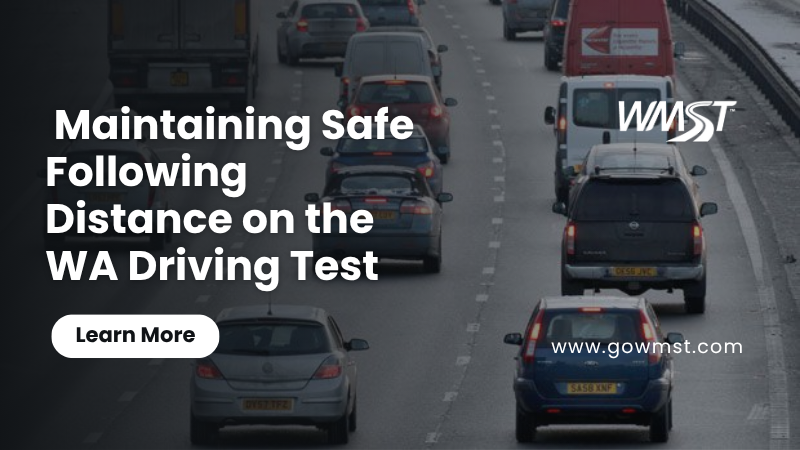Taking the Washington State DOL Skills Test is a major milestone. You’ve practiced your maneuvers, from parallel parking to backing around a corner, but one of the most critical skills the examiner will watch for is one you use every second: your following distance.
Failing to maintain a safe “space cushion” is one of the most common tailgating mistakes learners make, and it’s a clear sign to the examiner that you are not a defensive driver. In a state like Washington, which unfortunately ranks as one of the worst for tailgating incidents, proving you can manage your space is non-negotiable.
This guide covers what examiners look for and how to master the proper following distance for the WA driving test.
Why Space Management Is Key to Passing Your Skills Test?
During your test, your examiner is constantly assessing your ability to manage risk. A safe following distance isn’t just a number, it’s your reaction time. It’s the physical buffer of space that allows you to perceive a hazard (like brake lights, a swerving car, or a road obstruction) and react safely without panicking.
When an examiner sees you following too closely, they don’t see a driver trying to be efficient; they see a driver who has eliminated their own safety margin. This is a critical error because it demonstrates a lack of the single most important skill: defensive driving. Adhering to the examiner’s rules for space is just as important as performing a perfect parallel park.
The 3-Second Myth vs. The 4-Second Safety Standard
You may have heard of the “3-second rule.” While a common piece of advice, it is often insufficient for new drivers who are still developing their reaction speed and hazard perception.
At WMST, we teach the 4-second rule as the correct, safer standard for all new drivers in Washington. This provides a more reliable defensive driving space cushion and gives you the time you need to manage any situation.
How to Measure the 4-Second Rule:
- As the vehicle in front of you passes a fixed object (like a road sign, overpass, or distinct tree), start counting.
- Count clearly: “One-one-thousand, two-one-thousand, three-one-thousand, four-one-thousand.”
- If the front of your car reaches that same fixed object before you finish counting to four, you are following too closely. Ease off the accelerator and let the gap widen.
This technique works at any speed, whether you’re in a 20 mph zone or on the freeway, because the distance naturally extends as your speed increases.
Common Distance Mistakes That Cost Points
On your safe distance driving exam in WA, an examiner will be looking for these specific errors. Avoid them at all costs:
- Aggressive Tailgating: This is the most obvious error. If the examiner feels unsafe or has to verbally warn you to back off, you have likely made a critical mistake.
- Failing to Adjust: The 4-second rule is the minimum for perfect, dry conditions. Washington is famous for its rain. If you are on your Skills Test and it’s raining, foggy, or dark, you must extend that distance to 5, 6, or even more seconds. Failing to adjust shows a lack of critical thinking.
- Stopping Too Close: Space management also applies when you’re stopped. At a red light or in traffic, you should always be able to see the rear tires of the car in front of you touching the pavement. If you can’t, you’re too close and have left no room to maneuver in an emergency.
WMST Strategies for Better Driving Awareness
Reading about the 4-second rule is one thing; making it an automatic habit is another. This is where high-quality driver education makes the difference.
As part of our WMST safety lessons, we build this habit from day one. Our curriculum, which is based on national best practices, goes beyond just teaching you to pass the test. We focus on building lifelong defensive drivers.
Unlike schools that substitute valuable road time with ineffective simulations, WMST provides six full hours of actual WMST behind-the-wheel training with a certified instructor. During this one-on-one time, you will practice and master the 4-second rule in real traffic, on real Washington roads, until it becomes second nature. We ensure you have the practical, hands-on experience to be a safe and confident driver for life.
Frequently Asked Questions (FAQs)
What is the correct following distance in WA?
The Washington Driver Guide advises maintaining a “reasonable and prudent” distance. However, for new drivers, the industry safety standard taught by WMST is the 4-second rule in ideal conditions.
Will I fail for driving too close to another car?
Yes, you can absolutely fail your Skills Test for following too closely. It is considered a critical safety error that demonstrates a lack of defensive driving skills and awareness.
How do examiners measure safe distance?
Examiners are highly trained and use the same method you should: they pick a fixed object and count the seconds between your car and the car ahead. They can spot tailgating instantly.
Does the rule change in bad weather?
Yes, absolutely. The 4-second rule is the minimum for dry, clear weather. In rain, fog, at night, or on slippery roads, you must increase your following distance to 5, 6, or more seconds to account for reduced visibility and longer stopping times.
How does WMST teach defensive spacing?
WMST ingrains this skill through our superior curriculum and our guarantee of six full hours of behind-the-wheel instruction. Our students practice the 4-second rule in real-world scenarios with an instructor, ensuring it becomes a core driving habit, not just a fact to memorize for the test.
